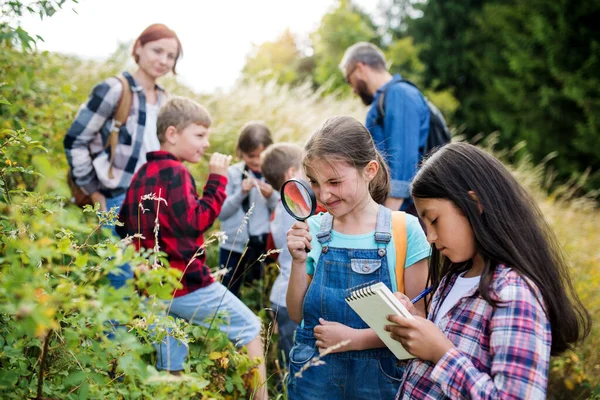Overview

Many educators are familiar with the benefits exposure to nature has on the development of the whole child, including increased empathy, greater physical health, enhanced emotional well-being, a sense of community with the natural world, and stimulation of the imagination. There is a long-standing tradition of educators bringing the outdoors into education through various means, but this guide will focus on classroom gardens, schoolyard habitats, and wildlife gardens. This guide seeks to be a resource for educators who wish to develop lessons that bring various aspects of nature and the natural world into the classroom, library, and educational environment as a whole.
depositphotos.(n.d). Student Field Trips.https://depositphotos.com/photos/students-field-trip.html
Why It Matters
Scholarly Resources: How Does Outdoor Education Benefit Young Students?
Promoting Children's Mental, Emotional, and Social Health through Contact with Nature: A Model
Maller, J.C. (2009). Promoting children's mental, emotional, and social health through contact with nature: A model. Bradford, 109(6), 522-543
Mental health is an important educational factor and supporting the mental health of students is an important part of teaching. Ecological theory suggests that interaction with nature has a positive effect on the mental health of children, including intellectual health, emotional health as well as creativity and social well-being. In this article the authors describe research in which adult educators explain their perceptions of how nature effects the mental health of students.
Childhood Development and Access to Nature: A New Direction for Environmental Inequality Research
Strife, F., Downey, L.(2009). Childhood development and access to nature: A new direction for environmental inequality research. Organization & Environment, 22(1), 99-122
Access to greenspace and to nature, or the lack of access, has major impacts on students, particularily impoverished communities and inner city communities. Environmental inequality is investigated in this article, including pollution, hazzards, and their effects, as well as overall negative effect of the modern lack of free-play in natural environments on virtually all children from all races and backgrounds.
Discovering Nature: The Benefits of Teaching Outside the Classroom.
Vessels-Jacobi, J. L. (2013). The benefits of teaching outside the classroom. Dimensions of Early Childhood, 41(3).
Nature-play and its physical, cognitive, and social-emotional benefits are explored and discussed, as well as the modern nature deficit that many children suffer from - a deficit that is likely contributing to the epidemics of obesity, attention deficit disorders, depression, and dissassociation from the natural world. Playgrounds are not substitutes for the emotional benefits of being immersed in the world that exists outside of human creation.
Animal-Assisted Interventions in the Classroom-A Systemic Review
Brelsford, V. L., Meints, K., Gee, N. R., & Pfeffer, K. (2017). Animal-Assisted Interventions in the Classroom-A Systematic Review. International journal of environmental research and public health, 14(7), 669. https://doi.org/10.3390/ijerph14070669
Companion animals are becoming more popular, including in the classroom. This article delves into whether or not the positive behavioral benefits include a positive effect on classroom interventions and interactions. Do studies indicate that animal interventions are helpful to children, including children with special needs, such as ASD, or mood disorders? By using control groups and conducting experiments in classrooms the authors try to ascertain the effects animals in the classroom may have reading, social and emotional learning, motor skills, physiological arousal, and overall classroom behavior, among others.
Social Behaviors Increases in Children with Autism in the Presence of Animals Compared with Toys
O'Haire, M.E., McKenzie, S.J., Beck, A.M., & Slaughter, V. (2013). Social behaviors increases in children with autism in the presence of animals compared with toys. PLoS ONE,8 (2). https://doi.org/10.1371/journal.pone.0057010
Animals often encourage positive social interactions between people. The researchers of this article question whether this is equally true of children with ASD.This study employs Social Skills Rating Systems, interactive sessions with both toys and with animals, and behavioral coding to create and assess a data set. Findings indicate that children with ASD have greater social interaction with their peers while in the presence of animals, and engaged in a greater number of positive emotional displays.
Scholarly Resources: How Does Outdoor Education Benefit Nature and our Natural Environment?
Demir, F.B., Meryem, K., Aksoy, D., Kaya, R., & Kaya, E. (2023). An action research on improving environmental sensitivity of fourth grade primary school students: What happens in the school garden?. International Journal of Educationan and Literacy,11(2).54-63
Environmental awareness is critical for the survival of the natural world, and educating todays youth by fostering a sense of stewardship through educational immersion in nature is an important part of creating that awareness. Many students find environmental workshops interesting, and fun, and school gardens provide hands-on opportunities to contemplate, plan, execute, nurture, and increase enviromental sensitivity in students.
Empathy with Nature Promotes Pro-Environmental Attitudes in Preschool Children
Li Y., Zhao, Y., Huang, Q., Deng, J., Deng, X., & Li, J. (2023). Empathy with nature promotes pro-environmental attitudes in preschool children. PsyCh Journal
Identifying factors that inspire pro-environmental attitudes in children is a critical component of protecting environment. Authors investigate the relationship between empathy with nature and pro-environmental attitudes through various studies. Findings indicate that educational practices that include nature, specifically animals, does have a positive effect on the overall pro-environmental attitudes of young students. As young people will continually inherit the stewardship of our natural world, fostering a pro-environmental attitude is of the utmost importance and benefit of nature.
